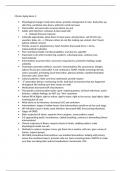Chronic Aging Exam 1:
Physiological changes: body slows down, prostate enlargement in men, body dries up,
skin thins, peristalsis slow down, sphincter rectal increases
Pancreatitis: eat pancreatic enzymes before you eat
Adults with infection: confusion & decreased LOC
o Delayed immune response
Culturally appropriate: allow them to have space, actively listen, call Mr/Mrs (no
sweeties, baby, etc.…), Chinese culture do not like making eye contact, don’t touch
patient without consent
Priority concerns: polypharmacy, heart function (increased stress = stress,
malnourished), hydration
Poor nutritional intake: functional abilities, oral dryness, appetite
Important to do when transferring a patient: a discharge plan, continue care,
teach/educate
Interventions to protect skin: sunscreen, long sleeves, protective clothing, shade,
umbrella
Teaching to promote wellness: vaccines/ immunizations (flu, pneumonia, shingles
(above 50 you get 2 doses BUT is not continuous, TDAP), Health screenings (breast,
colon, prostate), promoting social interaction, physical activity, nutrition/hydration
(increase carbs, lower fats)
Cultural patients: Make sure they understand, provide respect
3rd generation theory: reminiscing on life, look back at moments that has happened
throughout life (making sure their needs are met)
Medications that lowers BP: beta blockers
Therapeutic communication styles: open- ended questions, sit/level with them, active
listeners, validate feelings, do NOT use “why” questions
Patient Bill of Rights: right to refuse, right to leave, right to has access, legal rights, rights
involving plan of care
What alerts us to infections: decreased LOC and confusion
Interventions/ stages of widow hood: what interventions would we do for each stage
HIV infection cause in body: yeast infection, decreased WBC (reoccurring infections)
Stages of GRIEF:
Elder suspected of abuse: separate from caregiver, assess patient, report
S/S approaching death: incontinence, rattled breathing, coolness in extremities j(know
interventions)
Chronic trajectory of illness: impacts clients & family, stabilize patient, make
physiological needs are met
Methods to reduce caregiver stress: get them into a routine, self-care, give a sense of
humor, support groups
HIV/AIDS precautions/interventions: use standard precautions, helping with privacy,
assess the emotional aspect, promote safe sex, have screenings done, WATCH to make
sure they are taking their antiviral medications: check levels- CD4




